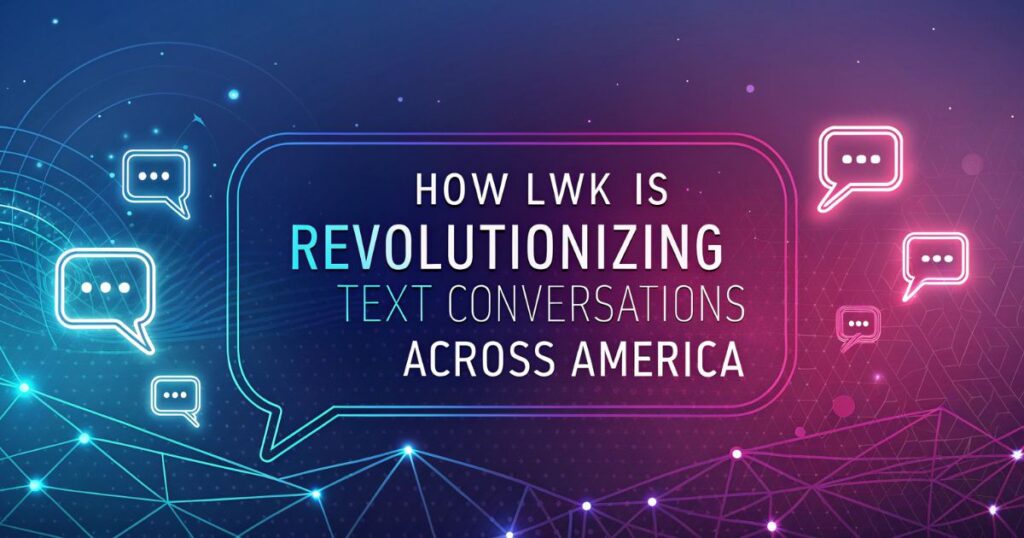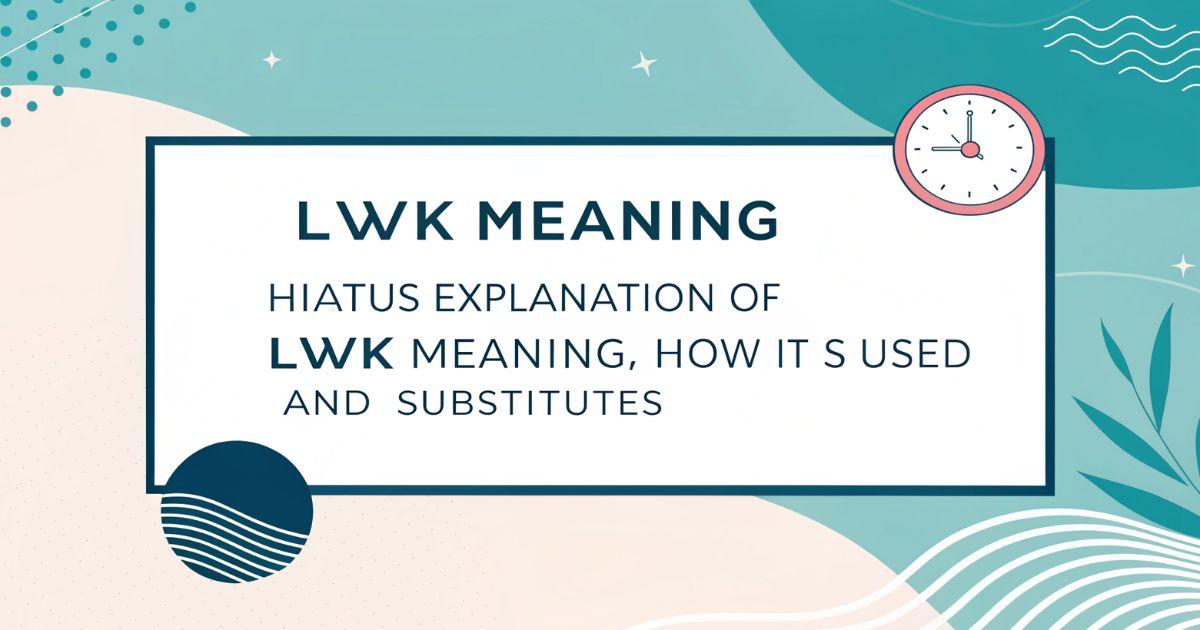LWK has exploded across American social media platforms, leaving many scratching their heads about its true meaning.
This comprehensive guide breaks down everything you need to know about this trending acronym.
Whether you’re a parent trying to decode your teen’s messages or a social media enthusiast staying current, you’ll master LWK usage by the end of this article.
What Does LWK Actually Mean? Breaking Down the Acronym That’s Taking Over Social Media
LWK stands for “Low Key” – a phrase that’s been circulating in American slang for decades but recently gained massive traction online. The acronym represents something done subtly, without drawing attention, or to a moderate degree.
When someone types LWK, they’re essentially saying “kind of,” “sort of,” or “a little bit.” It’s the digital equivalent of whispering your opinion rather than shouting it from the rooftops.
Think of LWK as your conversational dimmer switch. Instead of saying “I absolutely love pizza,” you might text “LWK obsessed with pizza right now.” It softens the statement while still conveying genuine interest.
The Real Story Behind LWK — Why This Abbreviation Became Internet Gold
The phrase “low key” originated in African American Vernacular English (AAVE) during the 1990s. Musicians, particularly in hip-hop culture, popularized the term before it spread to mainstream American vocabulary.
Social media platforms accelerated LWK’s transformation from spoken slang to written shorthand. Character limits on Twitter and the fast-paced nature of texting made abbreviations incredibly valuable.
Generation Z embraced LWK as their linguistic signature. Unlike millennials who favored “literally” and “basically,” Gen Z adopted LWK as their go-to modifier for expressing nuanced opinions.
The acronym gained particular momentum during 2019-2020 when TikTok users began incorporating it into captions and comments. Suddenly, LWK wasn’t just text speak – it became a cultural phenomenon.
How LWK Is Revolutionizing Text Conversations Across America

LWK transforms ordinary statements into more relatable, less aggressive communications. Instead of coming across as overly enthusiastic or dramatic, you can express genuine feelings with built-in humility.
Consider these conversation examples:
- “That movie was LWK terrible” (softer than “That movie sucked”)
- “I’m LWK nervous about tomorrow” (less dramatic than “I’m terrified”)
- “This song is LWK fire” (cooler than “This song is amazing”)
Text messaging benefits enormously from LWK because it prevents misunderstandings. When you can’t hear tone of voice, LWK signals that you’re being casual rather than intense.
The acronym also creates instant rapport. Using LWK shows you understand current slang trends and aren’t trying too hard to sound formal or outdated.
LWK in Social Media — Instagram, TikTok, and Twitter Usage Examples That Actually Work
Instagram captions frequently feature LWK to maintain that effortlessly cool aesthetic. Users write “LWK proud of this selfie” instead of appearing overly confident or self-absorbed.
TikTok comments utilize LWK for expressing opinions without starting arguments. “This trend is LWK overrated” sounds more diplomatic than harsh criticism.
Twitter threads incorporate LWK to soften controversial takes. Political discussions become less polarizing when prefaced with “LWK think this policy might work.”
Snapchat stories often include LWK in text overlays. “LWK having the best day” appears more authentic than over-the-top enthusiasm.
Facebook posts from younger users sprinkle in LWK to bridge generational gaps. It helps them communicate with older relatives without abandoning their linguistic identity.
Decoding LWK Text Messages — What Your Friends Are Really Trying to Tell You
LWK serves as emotional armor in digital conversations. When friends use it, they’re often testing the waters before fully committing to an opinion or feeling.
“I’m LWK mad at you” translates to “I’m upset but want to discuss it calmly.” It’s an invitation for conversation rather than confrontation.
“That party was LWK lit” means “I had fun but don’t want to seem too excited.” It maintains social coolness while sharing positive experiences.
LWK also functions as a conversation softener. “I LWK disagree” feels less threatening than direct opposition, encouraging healthy debate rather than defensive reactions.
Understanding these nuances helps you respond appropriately. LWK statements usually want acknowledgment rather than intense reactions.
When to Use LWK (And When You Definitely Shouldn’t) — Timing and Context Guide
Casual conversations with friends, family, and peers represent LWK’s sweet spot. It fits naturally into relaxed digital communications where formality isn’t required.
Social media posts targeting younger audiences benefit from strategic LWK placement. It demonstrates cultural awareness and relatability.
Work environments present mixed scenarios. LWK works in casual Slack channels with close colleagues but avoid it in formal emails or presentations.
Academic settings generally discourage LWK usage. Professors and classmates expect standard English in assignments, discussions, and professional communications.
Family group chats can accommodate LWK depending on your relatives’ comfort with modern slang. Gauge their responses before making it a habit.
Never use LWK in job interviews, legal documents, medical communications, or emergency situations where clarity is paramount.
LWK vs Similar Slang — Understanding the Subtle Differences That Matter
“Kinda” and LWK serve similar functions but carry different cultural weights. “Kinda” sounds more universal while LWK signals awareness of current trends.
“Sort of” appears more formal than LWK. Choose “sort of” for slightly professional contexts and LWK for purely casual communications.
“NGL” (not gonna lie) often pairs with LWK but serves different purposes. NGL introduces honesty while LWK modifies intensity levels.
“Tbh” (to be honest) creates more serious tones than LWK. Use tbh for important revelations and LWK for casual observations.
“Lowkey” spelled out versus LWK abbreviated depends on your audience. Younger users prefer LWK while older millennials might stick with “lowkey.”
Perfect LWK Substitutes — Alternative Phrases That Pack the Same Punch
“Kind of” remains the most direct LWK substitute. It works across all age groups and maintains the same meaning without requiring slang knowledge.
“Somewhat” elevates conversations slightly while preserving LWK’s moderating effect. Perfect for semi-professional contexts.
“A little” or “a bit” capture LWK’s essence in more traditional language. They’re excellent choices for mixed-age group chats.
“Sort of” provides middle ground between formal and casual. It’s widely understood and doesn’t alienate any particular demographic.
“Moderately” works in academic or professional settings where LWK would be inappropriate but you need to express measured opinions.
“Quietly” or “subtly” can replace LWK when describing actions rather than feelings or opinions.
Generational Divide — How Different Age Groups Use LWK Differently
Generation Z (born 1997-2012) treats LWK as native language. They integrate it seamlessly into all digital communications without conscious effort.
Millennials (born 1981-1996) adopted LWK more deliberately. They often use it to connect with younger colleagues, friends, or family members.
Generation X (born 1965-1980) rarely uses LWK organically. When they do, it’s usually mimicking their children’s speech patterns or trying to appear current.
Baby Boomers (born 1946-1964) typically avoid LWK entirely. They prefer traditional expressions and may not understand its meaning without explanation.
Generation Alpha (born 2010-2025) inherits LWK as established vocabulary. They’ll likely create new variations or move beyond it entirely.
LWK Etiquette Rules — Professional vs Casual Settings and What’s Appropriate
Customer service communications should avoid LWK completely. Customers expect professional, clear language without trendy abbreviations.
Workplace Slack channels allow LWK in informal team conversations but not in company-wide announcements or client-facing messages.
Email signatures and formal correspondence have no place for LWK. Stick to standard business English for all official communications.
Social networking with colleagues requires careful consideration. LWK might be appropriate on personal posts but avoid it in professional networking contexts.
Conference calls and video meetings should exclude LWK from verbal communication. Save it for private chat messages during meetings if absolutely necessary.
Common LWK Mistakes That Make You Look Out of Touch (Avoid These Blunders)
Overusing LWK destroys its impact. Sprinkle it strategically rather than adding it to every other sentence.
Wrong contexts make LWK usage cringeworthy. Avoid it in serious discussions about health, finances, or major life decisions.
Forced integration sounds unnatural. Don’t shoehorn LWK into conversations where it doesn’t fit organically.
Mixing with formal language creates jarring contrasts. “I am LWK pleased to inform you” sounds ridiculous in business communications.
Explaining LWK after using it defeats the purpose. If your audience needs translation, choose different vocabulary.
Pronunciation confusion happens when people say “L-W-K” instead of “low key.” Always pronounce it as the full phrase in spoken conversation.
Regional Variations — How LWK Usage Changes Across Different US States
California users embrace LWK extensively, particularly in Los Angeles and San Francisco tech communities. It fits naturally with West Coast laid-back communication styles.
New York incorporates LWK into fast-paced urban conversations. New Yorkers appreciate its efficiency and directness.
Southern states show more reserved LWK adoption. Traditional communication preferences sometimes clash with modern internet slang.
Midwest usage varies significantly by city. Chicago and Detroit see higher LWK frequency than rural areas.
Texas cities like Austin and Houston embrace LWK through their young, tech-savvy populations. Rural Texas remains more traditional.
Florida demonstrates mixed patterns. Miami and Orlando use LWK heavily while smaller communities lag behind.
LWK in Pop Culture — Celebrity Usage and Viral Moments That Shaped Its Popularity
TikTok influencers popularized LWK through viral videos during 2019-2020. Major creators consistently used it in captions and spoken content.
Music artists incorporate LWK into lyrics and social media posts. Hip-hop and pop stars particularly embrace the term.
Reality TV shows feature LWK in unscripted moments. Cast members use it naturally, introducing it to mainstream television audiences.
YouTube creators integrate LWK into video titles and descriptions. It helps them connect with younger demographics.
Celebrity Twitter accounts showcase LWK usage, legitimizing it among fans. When famous people use slang, it spreads rapidly.
Meme culture amplifies LWK through shareable content. Viral memes often feature the acronym prominently.
Future of LWK — Will This Slang Term Stand the Test of Time?
Language evolution suggests LWK will eventually fade as newer slang emerges. Most internet acronyms have 3-5 year peak periods.
Mainstream adoption could extend LWK’s lifespan. If older generations embrace it, longevity increases significantly.
Platform changes might accelerate LWK’s decline. New social media apps often introduce fresh linguistic trends.
Cultural shifts away from understated communication could reduce LWK usage. Future generations might prefer different expression styles.
Institutional acceptance in dictionaries and formal recognition could preserve LWK long-term. However, this rarely happens with internet slang.
International spread might sustain LWK globally. If non-English speakers adopt it, the acronym could outlast American trends.
Conclusion
LWK represents more than just internet slang – it’s a linguistic tool that helps Americans navigate modern digital communication with grace and authenticity.
Understanding its proper usage, context, and cultural significance ensures you’ll connect effectively with diverse audiences across social media platforms. Whether you choose to embrace LWK or stick with traditional alternatives, recognizing its impact on contemporary American English keeps you culturally informed and communicatively competent.
More Posts
Glizzy Meaning – Explained with Text Examples & Polite Replacement Terms
Top 42 Goodfella Meaning: The Ultimate Guide with Clear Examples
What Does It Symbolize When a Ladybug Lands on You

Welcome to Brightnis! I am the admin and creator of this platform. I love questioning ideas and exploring different situations. My goal is to encourage critical thinking and help people see things from new perspectives. Join me in discussing thought-provoking topics and finding unique solutions to everyday challenges!






